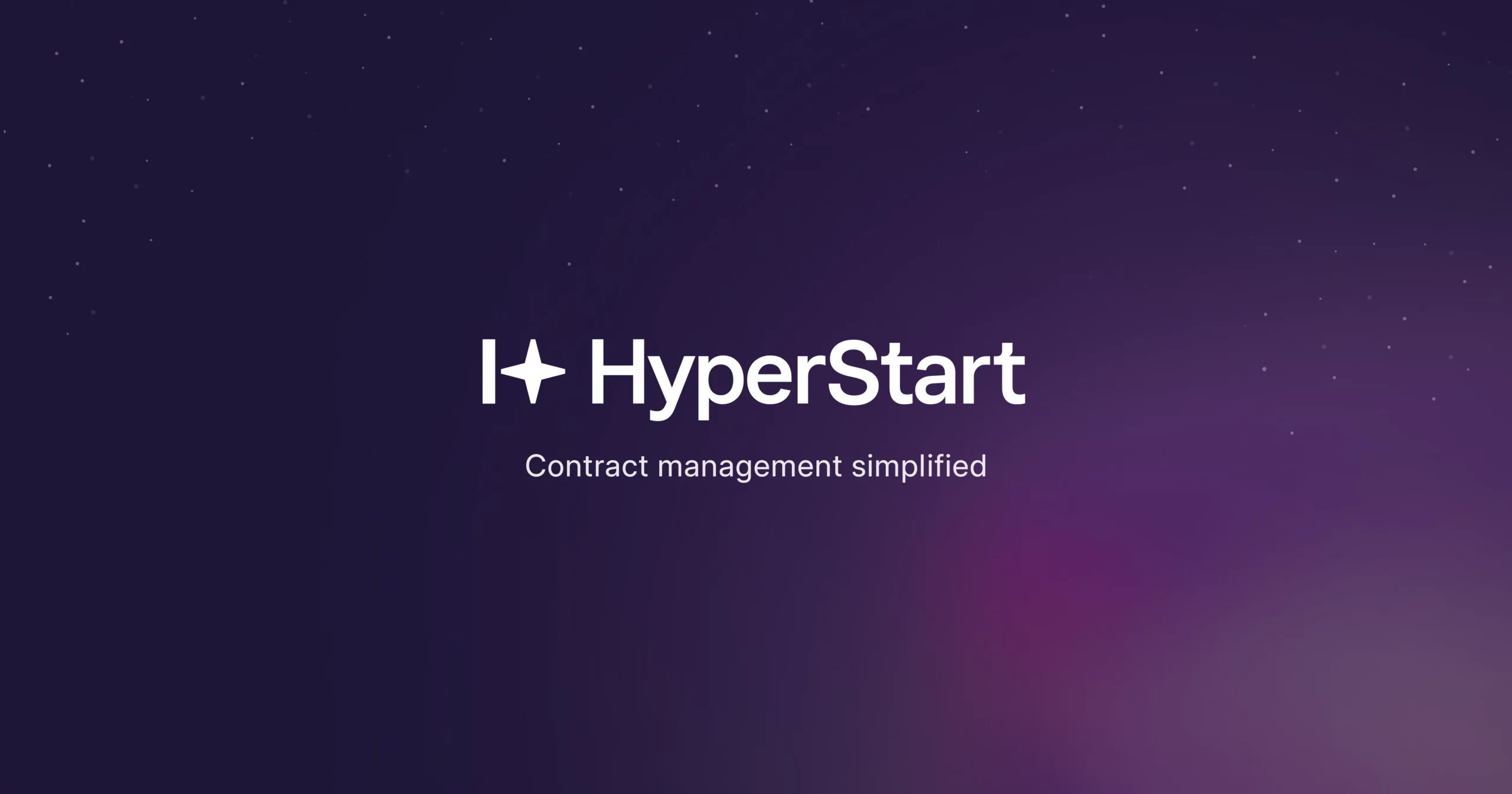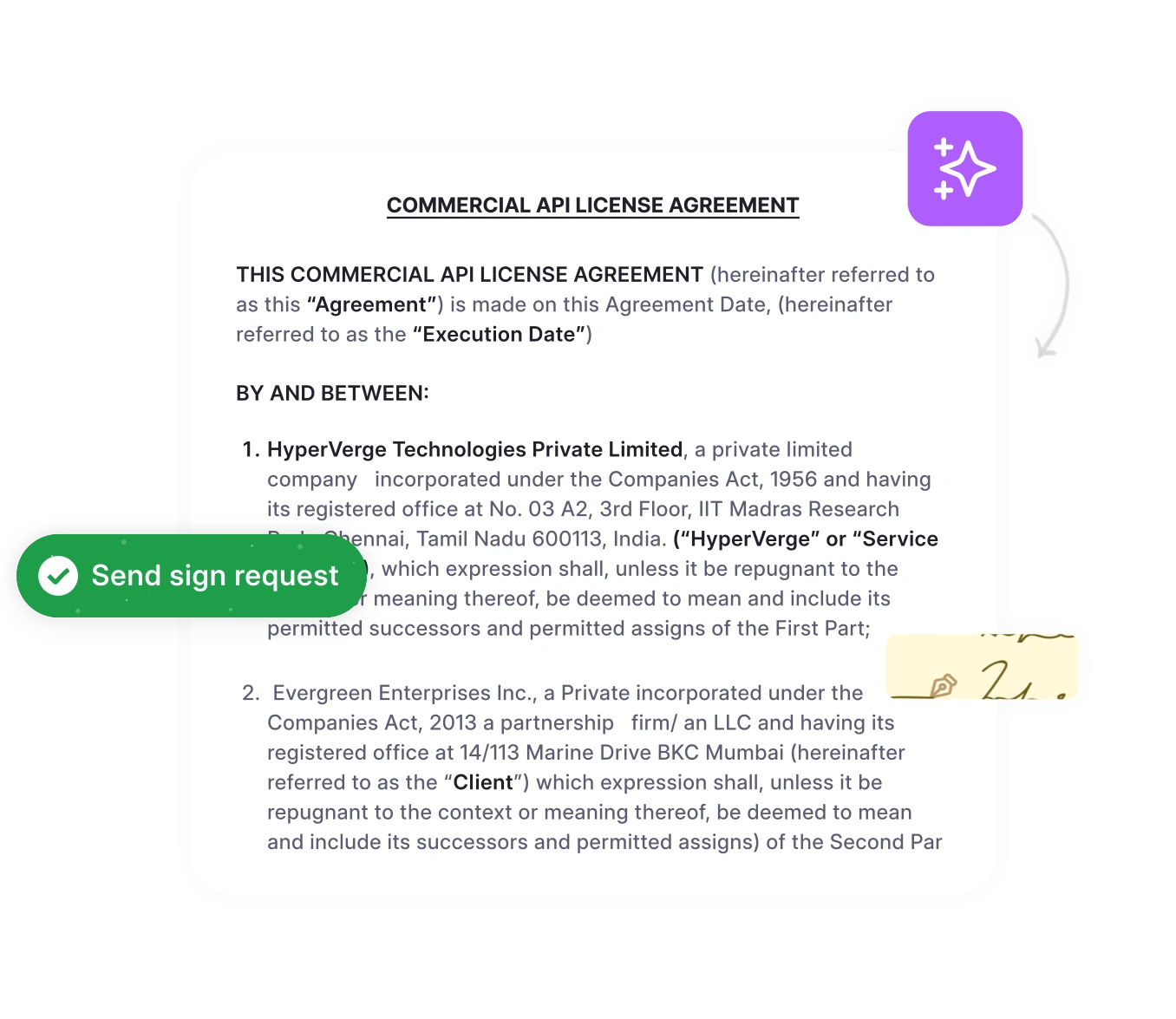Managing contracts with third parties can be tricky, mainly due to increased contract complexity, divided obligations, and increased commitments. At the same time, effectively managing third-party contracts is important for efficiency and compliance.
In this blog post, we will discuss the tips, processes, and practices for effective third-party contract management. We will help you get answers to questions like:
What are the use cases for third-party agreements?
What constitutes a third-party contract?
What makes them crucial for compliance?
How can you build a process to handle these contracts efficiently?
Let’s start with the basics, which is understanding third-party contracts.
What is a third-party contract?
A third-party contract is a legally binding document that regulates business relations between two primary contracting parties and an additional third party.
Unlike the classic two-party agreements, third-party contracts have additional stakeholders involved in the deal. Here’s how third-party contracts categorize these stakeholders:
First party: Organization or the party that receives goods and services.
Second party: Organization or individual offering the goods, services, or benefits to the first party as per the contract.
Third party: An additional party that helps the second party successfully deliver the commitments made to the first party. This party brings its expertise, skills, and input.
Here’s an example of a third-party contract to help you understand the concept:
A retailer enters a contract with a manufacturer to procure goods like clothing, apparel, and lifecycle products. The manufacturer employs an external Logistics Service Provider (LSP) to manage deliveries, making it the third party. The LSP’s input is essential for executing the contract between the retailer and manufacturer.
Different businesses use third-party agreements in various ways. Let’s discuss scenarios where these types of contracts are used.
When are third-party contracts used?
Third-party agreements are used whenever an organization plans to outsource a process or hire a subcontractor to supplement the fulfillment of existing contracts. This is usually the case with Service Level Agreements (SLAs) and vendor contracts, among others.
A third party may fall into either of the following categories:
Beneficiary: A beneficiary receives benefits from the contract between two parties. This type of third party has no direct obligations in the contract. Example- In a life insurance contract, the policyholder and the insurance company are two main parties, and the policyholder’s nominees/family members are beneficiaries.
Assignee: An assignee is a third party to whom either of the two contracting parties has assigned certain privileges. The assignee then exercises these rights as stated in the contract. For example, an organization that contracts a software license may transfer its license rights to another organization, entitling it to use the software.
Delegate: A delegate is a party delegated to perform specific tasks or uphold certain obligations in the contract by either party. The original party is still responsible for obligations. Example- A construction company and its client may delegate certain tasks, like electrical work and plumbing, to another subcontractor.
In retrospect, third-party contracts are used whenever either of the two contract parties needs to appoint an external party to execute the contract. For effective deal execution, it is important to manage third-party contracts carefully.
4 benefits of effective third-party contract management
Third-party contracts augment existing parties with the right skills, expertise, and talent to execute the deal, making them critical legal instruments. Here are 4 ways in which effective third-party contract management benefits organizations:
1. Improves legal compliance
Contract compliance is mandatory, and non-compliance often results in lawsuits, penalties, and fines.
Managing third-party contracts helps realize the contract’s obligations, commitments, and responsibilities.
Well-managed third-party contracts help regain contract visibility and enhance contract tracking, thus improving compliance and minimizing the chances of contract breaches.
2. Promotes accountability
Third-party contracts have complex accountabilities. With different parties handling different aspects of the contract, chances of lack of accountability are high.
Well-managed third-party contracts help clearly define contractual responsibilities—thus promoting accountability of each party towards obligations.
With a clear view of responsibilities in the contract, organizations can ensure all parties are working towards successful contract execution.
3. Enhances business relations
Adding a third party to the contract risks existing business relations between the two primary parties.
Well-managed third-party contracts help foster long-term business relations between all parties.
With well-managed contract obligations, smooth negotiation cycles, and real-time tracking, organizations can improve business outcomes.
4. Saves valuable contracting time
The process of executing third-party contracts is lengthy and more complex than a simple two-party contract. All CLM stages—from contract creation to review, approval—and signing are modified.
Well-managed third-party contracts help boost contract TAT and execute the deal faster.
Spending less time on contracts and legal work gives contracting parties more time to focus on operations, deliverables, and obligations.
Manage Third-party Contracts 80% Faster
Choose HyperStart CLM and get more work done through AI. Review, redline, execute, and track third-party contracts in less time.
Thus, effectively managing third-party contracts is important for overall contracting success. Now, what is the process of managing contracts with third parties? Let’s find out.
How to manage third-party contracts
Managing third-party agreements can be tricky, especially with complex and high-stake contracts. Here’s the step-by-step process of managing third-party agreements, with actionable tips for each step:
1. Identify third-party outsourcing needs
Evaluate internal capabilities to determine if outsourcing will add efficiency, cost savings, or access to specialized expertise.
Which business processes fall outside your expertise and are required to fulfill the contract? Knowing this helps identify third-party outsourcing needs.
Set clear objectives and requirements for third-party involvement, considering short-term and long-term business goals.
2. Assign a point of contact for specific roles
Designate a primary contact to manage communications, expectations, and project updates with third-party vendors.
Ensure that the point of contact understands the scope of the contract, organizational objectives, and compliance requirements.
Create clear role definitions for each internal team member involved, ensuring cohesive collaboration and accountability.
3. Conduct due diligence on third parties
Assess potential vendors through background checks, financial stability analysis, and references to verify their credibility and capability.
Review any relevant certifications, regulatory compliance records, and previous performance history to ensure alignment with your standards and compliance with your contract with the primary party.
Evaluate the third-party risk management approaches, data security, and quality control to ensure they meet organizational requirements.
4. Negotiate the deal with third parties
Establish mutually beneficial terms and clearly outline responsibilities, deliverables, timelines, and compliance requirements during negotiations.
Focus on securing contract terms that protect the organization’s interests, such as non-compliance penalties and dispute resolution clauses.
Negotiate cost structures and payment terms that align with budget considerations, allowing room for flexibility if the project scope changes.
5. Review, approve, and execute the agreement
Before final approval, have your compliance officer and legal team review the contract to ensure it meets regulatory and organizational standards.
Secure approvals from key stakeholders and decision-makers, ensuring they understand all terms and conditions within the agreement.
Execute the contract with signatures from authorized parties on both sides, officially binding the terms of the agreement.
6. Track obligations, performance, and compliance
Monitor contract milestones, deliverables, and compliance metrics to ensure the third party meets all agreed-upon standards and obligations.
Use contract management software to track real-time performance data, costs, and risks, facilitating proactive issue resolution.
Schedule regular contract reviews with the third-party vendor to discuss progress, address challenges, and make adjustments as necessary.
7. Propose renewal or termination at the term end
Evaluate the third party’s performance throughout the contract term to decide whether renewal is beneficial based on cost, compliance, and quality of service.
If renewal is favorable, initiate renegotiation discussions to update terms based on any new business requirements or changes in market rates.
For termination, plan for a smooth transition by ensuring any required handover, asset return, or knowledge transfer.
Simplify Third-party Contract Management
HyperStart CLM helps unify all CLM processes into one platform. Spend less time contracting and more time focusing on what matters.
Follow this process to reduce friction and enhance compliance with your third-party agreements. In addition to these steps, certain contract management best practices can further streamline how you manage your third-party deals.
5 best practices for managing third-party contracts
Vendor contract management for third parties, especially with traditional contract management approaches, is time-consuming and inefficient. Here are 5 third-party contract management best practices you can implement for better management of third-party contracts:
1. Pre-plan an exit strategy
Challenge: In cases where third-party contracts are not fulfilling their purpose, termination becomes necessary. However, many third-party contracts become difficult to terminate due to a lack of a proper exit strategy.
Solution: Develop a clear exit strategy when contracting with a third party. With clear exit steps, termination conditions, and well-defined timelines, exiting a contract becomes easier and gives you more flexibility in operations.
2. Avoid ambiguous clauses
Challenge: Vague or unclear clauses in third-party agreements lead to confusion, misinterpretations, unfulfilled obligations, and legal disputes. Such clauses may even strain relations between the two parties.
Solution: When creating a contract with third parties, ensure simple and compliant legal language that leaves no room for misinterpretation. Moreover, thoroughly review the drafted agreement to minimize room for error and maximize clarity in responsibilities.
3. Ensure data confidentiality
Challenge: Third-party outsourcing may expose your counterparty’s data to external entities. There’s often a risk of data breaches, where sensitive counterparty data may be exposed or misused—potentially hampering business relations and leading to lawsuits.
Solution: When entering agreements with third parties, ensure robust data confidentiality clauses in the contract. Also, take additional steps to maintain data confidentiality and controlled access, thus reducing the chances of data breaches and misuse.
4. Track obligations diligently
Challenge: With multiple deadlines, obligations, and commitments surrounding third-party contracts, there is a high chance of missing deliverables, neglecting compliance requirements, and breaching the contract.
Solution: Implement diligent and automated obligation management and tracking mechanisms. You can use tools like HyperStart CLM to auto-track obligations from your third-party agreements. With proactive and continuous obligation tracking mechanisms, you can stay ahead of deadlines and ensure compliance with third-party contracts.
5. Continuously monitor performance
Challenge: Most businesses solely focus on executing and fulfilling contracts, so contract performance often goes unnoticed. However, monitoring and managing contract performance is essential for projecting results, identifying discrepancies, and dodging potential contract risks.
Solution: Implement robust and mutually agreeable contract management KPIs when monitoring third-party agreements’ performance. These metrics help measure contractual value, derive insights from agreements, and ensure that all parties meet the agreed standards while executing the contract.
Implementing these best practices helps manage third-party agreements effectively and achieve the best results. Using contract management software like HyperStart CLM further augments your third-party agreement management efforts and streamlines CLM processes.
Manage third-party agreements 5x faster with HyperStart CLM
Third-party contracts are complex to manage. With increased obligations, compliance, and higher risks of contract breaches, you are likely to spend more time managing the contract than executing it. HyperStart CLM changes this by automating mundane contract management tasks.
With reliable and accurate AI technology and automation-focused features, HyperStart CLM helps streamline how you manage third-party contracts. From setting obligations on auto-reminder mode to continuously tracking compliance and performance, HyperStart CLM does it all for you.
With HyperStart CLM, you can create, review, redline, approve, store, track, and analyze third-party contracts smartly—giving you more time to focus on what matters. Still unsure? Book a demo with HyperStart CLM today to discover unique use cases of this tool for your organization.
Frequently asked questions
These mistakes can be costly and may often lead to non-compliance. However, with smart third-party contract management software like HyperStart CLM, you can automate redundant CLM tasks and improve third-party agreement management.
You can generate alerts for upcoming obligations, improving visibility into agreements and ensuring no third-party obligation goes unnoticed.










